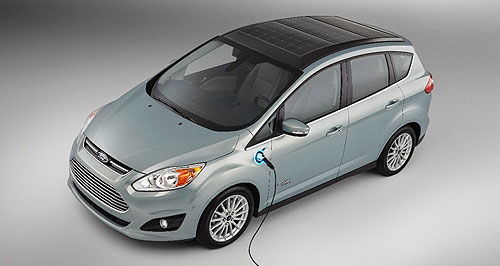Make / Model Search
Future models - Ford - C-MaxFord’s solar-powered C-MaxTime in the sun: The roof panels and solar concentrator on this Ford C-max concept could one day help take pressure off the power grid. Blue Oval develops C-Max PHEV that charges its batteries from the sunGallery Click to see larger images 6 Jan 2014 FORD will unveil a solar-powered version of its C-Max plug-in hybrid hatchback at the International CES in Las Vegas this week. The Solar Energi Concept has a line of solar panels installed on the roof, fed by a concentrator that acts as a magnifying glass to direct more intense rays. This system diminishes the need for the PHEV’s batteries to be charged via the conventional power grid. Ford says its data suggests the sun could power up to 75 percent of all trips made by an average driver in a solar hybrid vehicle. This could be especially important in places where the electric grid is underdeveloped, unreliable or expensive to use. Ford claims the concept requires a day’s worth of sunlight to deliver the same performance as the conventional C-MAX Energi plug-in hybrid, which draws its power from the (often coal-fired) grid. By using renewable power, Ford estimates a reduction in annual greenhouse gas emissions of four metric tons for a “typical owner”. To put this into perspective, four metric tons is roughly what the average US household uses in four months. The roof-mounted cells were developed by SunPower. The Georgia Institute of Technology helped develop the solar concentrator, which uses a special Fresnel lens (a patent-pending design originally developed for lighthouses) to direct sunlight to the solar cells while boosting the impact of the sunlight by a factor of eight. Similar in concept to a magnifying glass, the system tracks the sun as it moves from east to west, drawing enough power from the sun through the concentrator each day to equal a four-hour battery charge (8 kilowatts). With a full charge, Ford C-MAX Solar Energi Concept is estimated to have the same total range as a conventional C-MAX Energi of up to 1000km, including up to 30 electric-only kilometres. The vehicle still has a charge port, and can be charged by connecting to a charging station via cord and plug so that drivers retain the option to power up via the grid. Good for cloudy places. After the C-MAX Solar Energi Concept is shown at CES, Ford and Georgia Tech will begin testing the vehicle in real-world scenarios. The outcome of those tests will help to determine if the concept is feasible as a production car, Ford says.  Read more10th of May 2013  Hyundai reaches for the sunKorea’s largest roof-mounted photovoltaic solar array to be fitted to Hyundai plant28th of January 2013  Sunny side up for VW plantVolkswagen opens America’s biggest car plant solar power system to build PassatsAll future models Alfa Romeo Alfa Romeo Abarth Abarth Alpine Alpine Alpina Alpina Audi Audi Aston Martin Aston Martin BMW BMW Bentley Bentley Chery Chery Brabham Brabham Chrysler Chrysler Chevrolet Chevrolet Cupra Cupra Citroen Citroen DS DS Dodge Dodge Fiat Fiat Ferrari Ferrari Foton Foton Ford Ford Great Wall Great Wall FPV FPV Haval Haval GWM GWM Honda Honda Holden Holden Hummer Hummer HSV HSV Infiniti Infiniti Hyundai Hyundai Jaguar Jaguar Isuzu Isuzu Kia Kia Jeep Jeep Land Rover Land Rover Lamborghini Lamborghini Lexus Lexus LDV LDV Mahindra Mahindra Lotus Lotus Mazda Mazda Maserati Maserati Mercedes-AMG Mercedes-AMG McLaren McLaren MG MG Mercedes-Benz Mercedes-Benz Mitsubishi Mitsubishi Mini Mini Opel Opel Nissan Nissan Peugeot Peugeot Pagani Pagani Proton Proton Porsche Porsche Renault Renault Ram Ram Rover Rover Rolls-Royce Rolls-Royce Skoda Skoda Saab Saab SsangYong SsangYong Smart Smart Suzuki Suzuki Subaru Subaru Toyota Toyota Tesla Tesla Volvo VolvoMotor industry news |
Click to shareFord modelsResearch Ford All future models Alfa Romeo Alfa Romeo Abarth Abarth Alpine Alpine Alpina Alpina Audi Audi Aston Martin Aston Martin BMW BMW Bentley Bentley Chery Chery Brabham Brabham Chrysler Chrysler Chevrolet Chevrolet Cupra Cupra Citroen Citroen DS DS Dodge Dodge Fiat Fiat Ferrari Ferrari Foton Foton Ford Ford Great Wall Great Wall FPV FPV Haval Haval GWM GWM Honda Honda Holden Holden Hummer Hummer HSV HSV Infiniti Infiniti Hyundai Hyundai Jaguar Jaguar Isuzu Isuzu Kia Kia Jeep Jeep Land Rover Land Rover Lamborghini Lamborghini Lexus Lexus LDV LDV Mahindra Mahindra Lotus Lotus Mazda Mazda Maserati Maserati Mercedes-AMG Mercedes-AMG McLaren McLaren MG MG Mercedes-Benz Mercedes-Benz Mitsubishi Mitsubishi Mini Mini Opel Opel Nissan Nissan Peugeot Peugeot Pagani Pagani Proton Proton Porsche Porsche Renault Renault Ram Ram Rover Rover Rolls-Royce Rolls-Royce Skoda Skoda Saab Saab SsangYong SsangYong Smart Smart Suzuki Suzuki Subaru Subaru Toyota Toyota Tesla Tesla Volvo VolvoMotor industry news |















Facebook Twitter Instagram